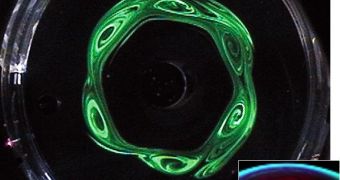Many people are familiar with the Great Red Spot feature of Jupiter, the large-scale storm that could encompass the Earth three times over. But it would appear that most gas giants in our solar system have secrets to keep, experts say. One such cosmic mystery is why the North Pole of Saturn features a hexagonal structure of nearly perfect geometrical proportions. Its presence has fascinated scientists since it was first discovered, and now the issue appears to have been partially solved.
Researchers recently managed to obtain the same type of structure in the tightly controlled confines of scientific laboratories, using nothing more than water and a spinning table. This accomplishment could make future studies of the hexagonal formation possible, as it gives investigators a clue to the basic phenomena at work in producing it. The study was conducted at the University of Oxford in the United States, by a team of scientists led by physicists Ana Claudia Barbosa Aguiar and Peter Read.
The team used a 30-liter tank of water to simulate Saturn's atmosphere. Inside the cylinder, they placed a small ring, whose motions they could control. As they started spinning the “core,” the water was set in motion, and the group tracked its motions using green dye. They were aiming to create jet streams, the bands that give Saturn its stripped appearance. What puzzled the group was learning that the speed of the spinning ring was directly related to the shape of the ensuing rings. Additionally, once the speed passed a certain threshold, the shape of the rings started modifying.
As the team changed various parameters of the ring, they eventually obtained polygons, including hexagons similar to the one visible in the images of Saturn sent back by the NASA Cassini spacecraft. “We could create ovals, triangles, squares, almost anything you like,” Read says of the shapes made possible by controlling the rings. “These results are very intriguing. The team has formed what I think is a landmark paper that could stand the test of time,” NASA Jet Propulsion Laboratory (JPL) planetary scientist Kevin Baines says of the work. The lab, based in Pasadena, California, manages the Cassini mission, ScienceNow reports.

 14 DAY TRIAL //
14 DAY TRIAL //